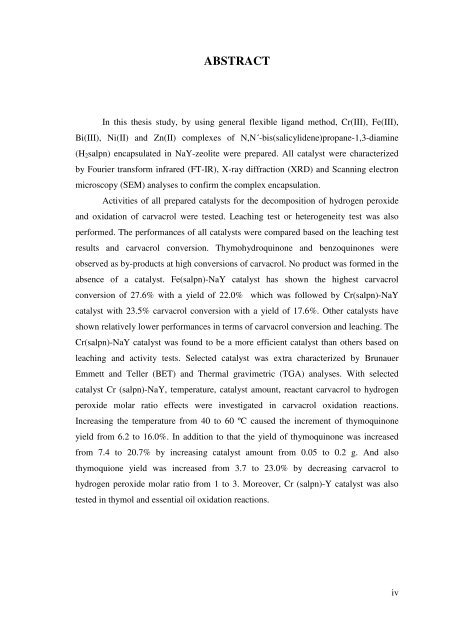the production of thymoquinone from thymol and carvacrol
the production of thymoquinone from thymol and carvacrol
the production of thymoquinone from thymol and carvacrol
Create successful ePaper yourself
Turn your PDF publications into a flip-book with our unique Google optimized e-Paper software.
ABSTRACT<br />
In this <strong>the</strong>sis study, by using general flexible lig<strong>and</strong> method, Cr(III), Fe(III),<br />
Bi(III), Ni(II) <strong>and</strong> Zn(II) complexes <strong>of</strong> N,N´-bis(salicylidene)propane-1,3-diamine<br />
(H2salpn) encapsulated in NaY-zeolite were prepared. All catalyst were characterized<br />
by Fourier transform infrared (FT-IR), X-ray diffraction (XRD) <strong>and</strong> Scanning electron<br />
microscopy (SEM) analyses to confirm <strong>the</strong> complex encapsulation.<br />
Activities <strong>of</strong> all prepared catalysts for <strong>the</strong> decomposition <strong>of</strong> hydrogen peroxide<br />
<strong>and</strong> oxidation <strong>of</strong> <strong>carvacrol</strong> were tested. Leaching test or heterogeneity test was also<br />
performed. The performances <strong>of</strong> all catalysts were compared based on <strong>the</strong> leaching test<br />
results <strong>and</strong> <strong>carvacrol</strong> conversion. Thymohydroquinone <strong>and</strong> benzoquinones were<br />
observed as by-products at high conversions <strong>of</strong> <strong>carvacrol</strong>. No product was formed in <strong>the</strong><br />
absence <strong>of</strong> a catalyst. Fe(salpn)-NaY catalyst has shown <strong>the</strong> highest <strong>carvacrol</strong><br />
conversion <strong>of</strong> 27.6% with a yield <strong>of</strong> 22.0% which was followed by Cr(salpn)-NaY<br />
catalyst with 23.5% <strong>carvacrol</strong> conversion with a yield <strong>of</strong> 17.6%. O<strong>the</strong>r catalysts have<br />
shown relatively lower performances in terms <strong>of</strong> <strong>carvacrol</strong> conversion <strong>and</strong> leaching. The<br />
Cr(salpn)-NaY catalyst was found to be a more efficient catalyst than o<strong>the</strong>rs based on<br />
leaching <strong>and</strong> activity tests. Selected catalyst was extra characterized by Brunauer<br />
Emmett <strong>and</strong> Teller (BET) <strong>and</strong> Thermal gravimetric (TGA) analyses. With selected<br />
catalyst Cr (salpn)-NaY, temperature, catalyst amount, reactant <strong>carvacrol</strong> to hydrogen<br />
peroxide molar ratio effects were investigated in <strong>carvacrol</strong> oxidation reactions.<br />
Increasing <strong>the</strong> temperature <strong>from</strong> 40 to 60 ºC caused <strong>the</strong> increment <strong>of</strong> <strong>thymoquinone</strong><br />
yield <strong>from</strong> 6.2 to 16.0%. In addition to that <strong>the</strong> yield <strong>of</strong> <strong>thymoquinone</strong> was increased<br />
<strong>from</strong> 7.4 to 20.7% by increasing catalyst amount <strong>from</strong> 0.05 to 0.2 g. And also<br />
thymoquione yield was increased <strong>from</strong> 3.7 to 23.0% by decreasing <strong>carvacrol</strong> to<br />
hydrogen peroxide molar ratio <strong>from</strong> 1 to 3. Moreover, Cr (salpn)-Y catalyst was also<br />
tested in <strong>thymol</strong> <strong>and</strong> essential oil oxidation reactions.<br />
iv
















